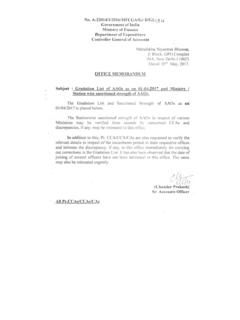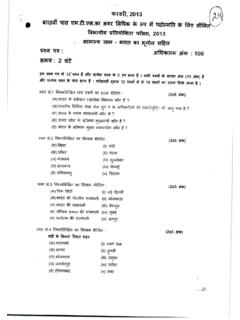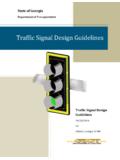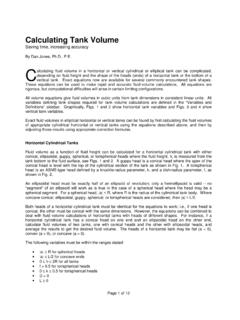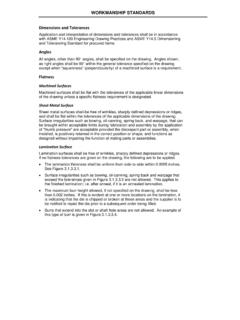Transcription of PREFACE TO THE DIGLOT EDITION - Controller …
1 PREFACE TO THE DIGLOT EDITION Under Article 343 of the Constitution, Hindi in Devnagri script is the official language of the Union. The Official Language (Amendment) Act, 1967 further provides the use of English language in addition to Hindi for all official purposes of the Union Government. For facilitating the progressive use of Hindi in Union Administration all non-statutory codes and Manuals of the Central Government Departments have to be translated into Hindi and all these publications will be in DIGLOT form the Hindi and English texts being given side by side. While every effort has been made to make the Hindi translation correspond to its English text as closely as possible, the English text may be referred to where the meaning is not clear from the translation.
2 Any errors or inaccuracies coming to light may kindly be brought to our notice, so that these are corrected in the next EDITION . Correction slips Nos. 1 to 387 have been incorporated in this EDITION . ( Sehgal) Controller General of Accounts New Delhi Dated, the 30th March, 2001 PREFACE TO THE EARLIER EDITIONS FIRST EDITION This Appendix, which supersedes the List of major and minor heads of Account of Central and Provincial Receipts and Disbursements contained in Appendix 7 to the Audit Code, Volume II, is issued by the Auditor General of India with the approval of the Governor General as directions under Section 168 of the Government of India Act, 1935. New Delhi, E.
3 BURDON The 1st April, 1938. Auditor General of India. SECOND EDITION This Appendix has been revised to incorporate the changes in the structure of accounts, which have been introduced with effect from 1-4-1962 in order to bring about a measure of rationalisation in the classification of Government transactions. Opportunity has also been taken to include in this List, major and minor heads sanctioned previously as temporary heads but which are now expected to continue permanently. 2. This EDITION supersedes this First EDITION of the Appendix and is issued by the Comptroller and Auditor General, with the approval of the President, in exercise of the powers vested in him under Article 150 of the Constitution of India.
4 New Delhi, ROY The 12th July, 1963 Comptroller and Auditor General of India THIRD EDITION The Appendix has been revised to incorporate the changes in the structure of accounts, which have been introduced from April 1974, in the classification of Government transactions. 2. This EDITION supersedes the second EDITION of the Appendix and is issued by the Comptroller and Auditor General with the approval of the President, in exercise of the powers vested in him under Article 150 of the Constitution of India. 3. The manner of identifying various major heads by numbers in vogue upto 1973-74 has also been revised.
5 Upto 1973-74 the major heads in the revenue and capital divisions were numbered serially, Roman numbers being employed on the receipt side, and Arabic numbers on the disbursement side and there was no numbering for debt, loan, deposit and remittance heads . Codification in the new structure of accounts given in this EDITION , is briefly explained below. 4. Each sector has an alphabetical series for identification. There is a code number for all the major heads in the Consolidated Fund, Contingency Fund and the Public Account, with a three digit Arabic number code. The first digit indicates whether a major head is in the receipt section, or expenditure on revenue account, or expenditure on capital account or public debt and loans and advances or Public Accounts sections.
6 The last two digits are for major heads , the same number representing the same major head, whether it is in the revenue receipt section, revenue expenditure section, capital expenditure section or loans and advances section. 5. The receipt major heads are assigned the block 020 to 199, expenditure major heads on revenue account from 211 to 399, expenditure major heads on capital account from 411 to 599, major heads under public debt from 601 to 610, those under loans and advances, inter-state settlement and transfer to Contingency Fund from 611 to 799 and the major heads in the Public Account from 801 to 899. FOURTH EDITION (1987) Classification of transactions in Government Accounts on a function-cum-programme basis was introduced from 1st April, 1974.
7 This functional classification had been evolved with the twin objectives of reflecting Government transactions in terms of functions, programmes and schemes and securing correspondence between accounting classification and Plan heads of development. 2. While the functional approach to classification is now well established, the divergence between Plan programmes and accounting classification has increased over the years. To bring about a closer correlation between Plan Schemes and Account heads , Government constituted a Committee consisting of representatives of the Controller General of Accounts, the Budget Division, the Planning Commission and the Comptroller and Auditor General of India to review the existing accounting classification and rationalise the heads of Accounts wherever required.
8 The recommendations of the Committee were examined and accepted by Government on the advice of the Comptroller and Auditor General of India and it was decided to give effect to the new accounting classification from 1st April, 1987. 3. While basic principles and the broad structure of accounts continue to remain as before, certain new sub-sectors have been introduced and a few major heads have been raised to the level of sub-sectors and minor heads to the level of major heads , because of their importance. Plan programmes have been provided at the minor Head level, wherever possible, so that expenditure on Plan programmes can be extracted from the accounts direct. The Code Numbers allotted to major heads have been changed from three digits to four digits to provide room for accommodating new functions, as and when they are evolved.
9 All heads of Accounts upto minor Head level have been given numeric codes to facilitate the computer-based Financial Information System. 4. This EDITION is being issued by the Controller General of Accounts, Department of Expenditure, Ministry of Finance, on the advice of the Comptroller and Auditor General of India, in terms of Article 150 of the Constitution of India. This EDITION supersedes earlier editions of the "List of major and minor heads of Accounts" issued by the Comptroller and Auditor General of India. GIRIJAESWARAN Controller General of Accounts New Delhi, Dated, the 1st July 1987 xiv GENERAL DIRECTIONS 1 General The minor heads prescribed under each major /sub- major head in this list and also permitted to be opened as detailed in the subsequent paragraphs of these directions may be divided into such subordinate heads (called 'sub- heads ') as may be needed to suit the local requirement of each Government.
10 The "sub-head" of Classification denotes and identifies the schemes undertaken in pursuance of programmes represented by minor heads or components of a particular programme, if the programme does not have any scheme, but represents non-developmental expenditure or expenditure of an administrative nature. The sub- heads should not be multiplied unnecessarily and new ones opened only when really necessary. Formal approval/issue of amendments by correction slips is not required for opening of new minor heads in the following circumstances:- (a) In the cases specified in the subsequent paragraphs of these directions with nomenclature of the heads indicated therein ( "Direction and Administration", "Other Expenditure" indicated in para below).




